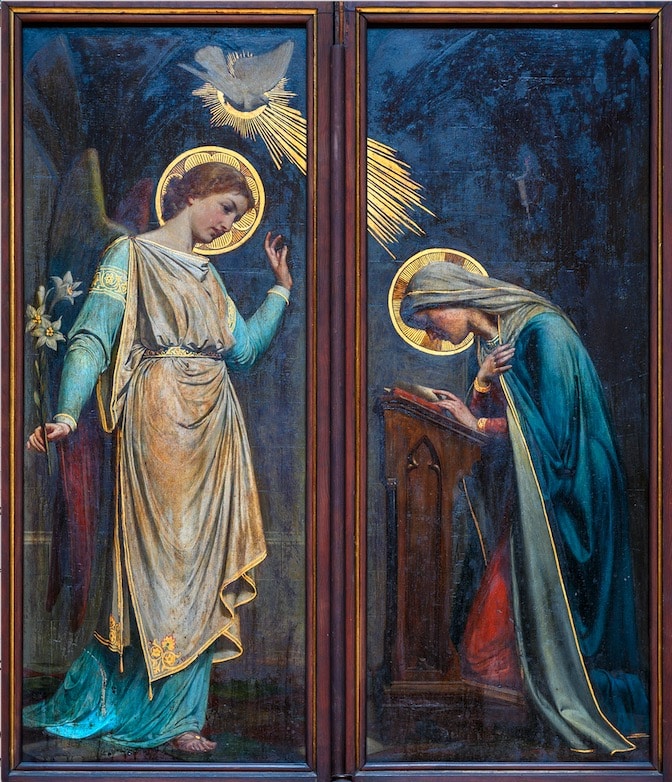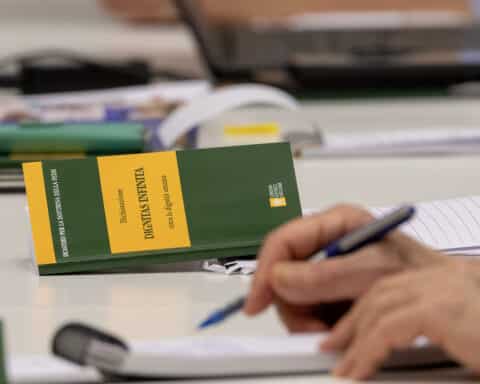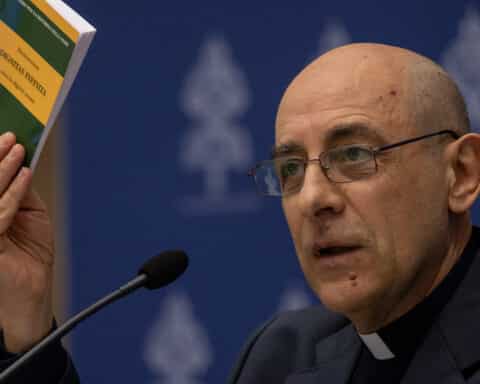The dogmatic constitution from the Second Vatican Council, entitled Lumen Gentium, promulgated on Nov. 21, 1964, sets forth the nature and mission of the Church. It begins by naming Jesus as the “light of the nations” (lumen gentium) and head of the Church, which is his body and includes all the faithful, both the visible society on Earth and the spiritual community in heaven. Jesus established the Church and ever sustains it as a sign and instrument of his grace, which is offered to all people (Nos. 1, 8).
The bulk of Lumen Gentium focuses on the different roles and charisms in the Church — laity, clergy and religious — and how the members travel together on their pilgrim way, witnessing to Christ on earth by lives of holiness, inviting others to join their ranks and moving toward full unity with him, his mother, and all the saints in heaven (No. 50).
Read more from our Church Document series here.
Lumen Gentium ends by pointing the faithful to Mary as “a wholly unique member of the Church” (No. 53) and “the model of virtues” (No. 65). Redeemed “in a more exalted fashion” through the merits of Jesus (even before his time on earth) and “taken up to heaven,” Mary is the first creature to enjoy the fruits of Christ’s salvation. She freely consented to God’s call to become the mother of Christ and cooperates with him. Therefore, she is rightly called “the mother of the members of Christ,” for she intercedes for all and directs them to her son (Nos. 53, 60-65).
Context
The sweeping panorama of the Church in Lumen Gentium embraces previous papal documents that centered on specific characteristics. For example, Satis Sognitum (Pope Leo XIII, Jun. 29, 1896) concentrates on the unity of the Church, and Mystici Corporis (Pope Pius XII, Jun. 29, 1943) identifies the Church with the Pauline teaching of the Body of Christ. The central ideas of both documents can be found in Lumen Gentium.
While the influences on Lumen Gentium are numerous — including the perspectives of all the prelates who commented on the drafts between 1962 and 1964 — two stand out. Vatican I’s constitution on the Church, Pastor Aeternus (1870), was very much on the mind of those at Vatican II. Pastor Aeternus focuses on the office of the papacy and its power, which obviously is one aspect of the Church. A fuller treatment was planned, but war and politics cut Vatican I short. The fathers at Vatican II, therefore, wanted to fill in the blanks with Lumen Gentium, particularly the relationship of the pope vis-à-vis the bishops (see especially Chapter 3).
The second major influence to mention here is Pope St. John XXIII, who convened Vatican II on October 11, 1962. Although Pope John died (Jun. 3, 1963) before Lumen Gentium was issued, his successor, Pope St. Paul VI, adopted his predecessor’s directive that the teachings of Vatican II should favor a pastoral approach, being open to the goodness of the world (including other religions) and sharing the good news of Jesus with all. Therefore, instead of concentrating only on intra-ecclesial matters or taking a defensive stance toward those outside Catholicism, the fathers of Vatican II sought to present the full hope and vision of the Church and what it meant for members and nonmembers, too.
Content
The final version of Lumen Gentium succeeds at presenting a comprehensive and dynamic portrait of the Church. The reader learns about many of the Church’s elements: features such as the Church’s four marks (one, holy, catholic and apostolic), the seven sacraments and the different roles of the members. But all of the elements serve to illuminate the essence of the Church as a pilgrim people journeying through history under the headship of Christ toward full communion with him in heaven.
The salvation of the world is central to the meaning of Lumen Gentium, as Christ established the Church to continue his saving work. Through the holiness and witness of its members, the Church not only receives Christ’s grace but dispenses it, all the while pointing to him as the one Savior. Lumen Gentium says that each “disciple of Christ has the obligation of spreading the Faith” so that others might be saved, too (No. 17). It’s worth noting that membership by itself does not guarantee salvation, for a person who is fully incorporated in the Church but does not persist in charity “is not saved” (No. 14). And members and non-members alike can fall prey to the deceptions of the devil (No. 16). Hence, the obligation to evangelize.
Regarding the visible society on earth, the Church consists of the laity, clergy and religious. Since they are all one in Christ, they share “a true equality” (No. 32) and participate in Christ’s mission according to their role. Each baptized person is a priest, prophet and king, called by Christ to offer sacrifice, preach the Good News and serve one’s neighbor. But there are different roles.
Members of the clergy are called to the ministerial priesthood. They have the responsibility of presiding at the liturgy, preaching the Gospel and governing the Church. Members of the laity enjoy what is called the common or baptismal priesthood, which shares in the salvific mission of the Church as well. However, the laity have the special vocation of being a leaven within society, seeking God’s will in temporal affairs and being a witness to Jesus. Religious may be members of the clergy or the laity who have received the special gift of conforming themselves to the evangelical counsels of Christ: chastity, poverty and obedience.
When each member seeks to fulfill his or her role, relying on God’s grace, the goal of heaven becomes that more clear for them and for those to whom they witness.
Call
Granted that the Church consists of different members fulfilling diverse roles, Lumen Gentium is quite clear “that all Christians in any state or walk of life are called to the fullness of Christian life and to the perfection of love” or, in other words, all are called to universal holiness (No. 40).

Holiness is not a passive reception of God’s grace. Rather, it is an active response to “hold on to and perfect in their lives that sanctification which they have received from God” (No. 40). Holiness is not exclusive to the “professional religious” (nuns and priests, etc.). It is the normal way of life for anyone who seeks to follow Christ, and it entails cultivating the relationship with God through daily prayer, acts of charity and participating in the life of the Church (such holiness, of course, results in being a witness of Jesus).
Mary is the model. One might think that because of the singular graces she was given, holiness came easier to her. The Scriptures suggest otherwise. Mary’s free consent to God to become the mother of Jesus placed her in difficult situations. Joseph considered divorcing her, she had to flee her homeland to protect her newborn, and she witnessed the brutal execution of her son. Who knows what else she endured? But we also know through Scripture that, by her faith and obedience, she endured until God took her up into heaven.
The call to holiness is shared by every disciple: to place one’s faith and trust in God, to receive Christ’s gifts that he offers through the Church by the power of the Holy Spirit, to persevere in love and to fulfill God’s will.
David Werning writes from Virginia.





